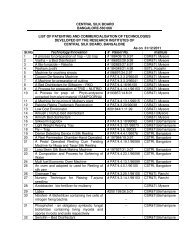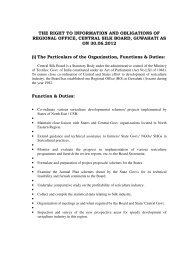Create successful ePaper yourself
Turn your PDF publications into a flip-book with our unique Google optimized e-Paper software.
• Design has been completed for fine tuning of mechanical lifting mechanism of<br />
jacquards to suit pit loom.<br />
• Under Product Development / Product Launching Programme gents shawl using<br />
2/40s peduncle yarn, ladies shawl using 2/40s peduncle yarn, fabrics made from eri<br />
spun yarn, furnishing fabrics from mill spun peduncle yarn , tasar saree produced<br />
on power-loom using wet reeled tasar yarn, Solapur chadars, Aurangabad chadars,<br />
Eri napkins, Imroo shawls, Prayer mats.<br />
Training and testing activities<br />
887 candidates were trained on post cocoon activities under various training programmes<br />
and 1,89,461 lots (cocoon, raw silk, fabric, water, etc.) were tested for physical, chemical<br />
and ecological parameters. One Trainers Training Programme (TTP) for CSTRI Scientists<br />
and Technical staff was also conducted for 24 persons.<br />
Decisions<br />
Validation trials should be completed quickly and technologies should be fine tuned<br />
Development of automation system retrofitting to CSTRI multiend reeling machine<br />
should be completed within 6 months by collaborating with industry units.<br />
Compile and come out with conclusive results on Tasar reeling machine. Develop a<br />
suitable Tasar reeling machine by the end of June 2012.<br />
Crispness of collar, release of fragrance, comfort etc., should be studied.<br />
Work out on sericin utilization in pharmaceutical, cosmetics and other allied fields.<br />
Diversification in the eri product areas<br />
Explore the possibility of diversifying eri silk for commercial items like bridal shoe<br />
etc.<br />
CSTRI should grow as a centre of excellence<br />
Develop Eri green cocoon cutting machine<br />
Take up studies related to mulberry silkworm pupa drying and disposal<br />
In order to attract more trainees and effective dissemination of technologies, the<br />
training course fee may be reduced<br />
NSSO Bangalore<br />
• A total of 118.14 lakh bivoltine hybrids and 162.52 lakh cross breed layings were<br />
produced till the end of February, 2012.<br />
• The egg recovery was 67.44 g/kg of cocoon in CSR Hybrids against the bench<br />
mark of 60-65 gram/kg seed cocoon in south zone and 55.0 g/kg cocoons against<br />
50 g in North zone; and in cross breeds, it was 30.36% laying recovery against the<br />
bench mark of 28% in south Zone.<br />
• Under basic seed production programme, 7.30 lakh bivoltine and 2.59<br />
lakh multivoltine layings have been produced.<br />
• Generated 686.02 lakh bivoltine and 253.96 lakh multivoltine seed cocoons. A total<br />
of 100.93 lakh bivoltine hybrids and 162.92 lakh cross breed layings were<br />
distributed through SSCs, SSUs and Franchisee CRCs.<br />
• 100.61 lakh seed cocoon were supplied to the SSPCs, LSPs & DOS of West<br />
Bengal and DOS, UP.<br />
10













